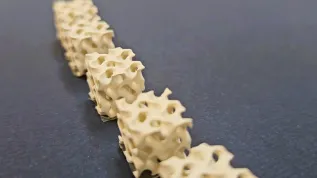
Histopathologists may gain a new imaging method, useful for cancer diagnosis. Confocal QPI may enable imaging of tissues using phase contrast. The test does not require staining or destroying samples.
Dr. Tomasz Wróbel from the SOLARIS National Synchrotron Radiation Centre told PAP: “American statistics show that histopathologists spend 90% of their time examining samples of healthy people, and only 10% of their time on difficult and complicated cases.
“This means that experts spend most of their time on analysing something that should be easily diagnosed. If we give people better tools for analysing samples, they will be able to save time and pay more attention to non-obvious cases that require knowledge and experience.”
The scientist joined the team of Dr. Martin Schnell from the University of Illinois, which developed the new imaging method. It can facilitate the work of histopathologists and provide scientists with new testing tools. The method is called confocal quantitative phase-contrast imaging (confocal QPI). The publication on this subject appeared in the journal Optica.
Dr. Wróbel said: “It is now possible to measure human tissues with the use of phase contrast, without artefacts, distortions. It has not been possible until now.”
According to the researcher, this technology opens up new possibilities for diagnostics and research. He said: “It allows us to extract information about the tested sample, such as the size, shape or location of the cell nucleus. Compared to other phase contrast methods, it is free of optical artefacts, for example halo. Thanks to it, we obtain a high-quality image that gives a lot of reference information.”
He explains that the cell nuclei shape gives histopathologists information about neoplastic changes. The nuclei of healthy human cells are almost round. However, if they change size, shape or become irregular, it may be a sign of neoplastic changes. In order to see the nucleus of a cell, it is usually necessary to stain a sample. Thanks to staining, the cell nucleus becomes clearly visible under the microscope.
A slightly different type of staining works best for each disease: one allows to see the shape of the cell nucleus, another - collagen fibres, yet another - calcifications. The histopathologist must therefore decide which staining to choose in a given case.
“Meanwhile, our method does not require staining. We get a lot of additional information without destroying the sample,” said Dr Wróbel.
He added: “There are difficult situations where staining must be performed a number of times on one sample. And then it is good to have an ace up your sleeve: an additional method that will provide information in an easy way.”
The new imaging method combines synthetic optical holography with phase contrast imaging. Dr. Wróbel says that part of imaging is laser-illuminating the sample, which is moved closer to and farther from the lens. The laser beam passes through a special lens that performs an interferometric measurement. The resulting information obtains a holographic image of the sample.
“Thanks to this,” says Dr. Wróbel, “we show the possibility of imaging tissues, and not just - as previously - single cells. Tissues are more difficult for high-resolution contrast imaging due to their relatively greater thickness and level of complexity. Light passing through the object refracted and interfered many times, resulting in a lot of artefacts and distortions. The use of the confocal variety in combination with holography allows to unravel this information.”
He adds that the image collected by the microscope is digitally processed to extract spatial information. This gets a clearer picture than ever before.
He said: “So far, we have shown that such a new method of imaging is possible.”
Although the technology is here, the device itself, which would allow such observations to be carried out in laboratories, will not appear on the market soon. First, it needs to be improved, the final product developed, and then it must be tested in clinical trials.
PAP - Science in Poland
lt/ zan/ kap/
tr. RL













